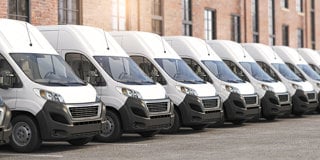Greater support is needed for the electric van transition to ensure their uptake does not keep falling behind that of their zero-emission car counterparts.
In its latest Road to Zero Report Card, industry body British Vehicle Rental and Leasing Association (BVRLA), says that while overall progress in the transition to EVs is accelerating, there are many imbalances across different sectors and use cases.
“We’re past the early adoption phase of EVs,” says Toby Poston, director of corporate affairs at BVRLA. “We’re at the hard yards stage where none of the decisions are easy and all the decisions you can make come with a lot of complexity and cost.
“The easy business cases have all been adopted, the clear policy wins have been have been seized. I think we're now into the area where we've got some really tough challenges and we’ve got a lot solutions that are both expensive and very complex.
“We’re definitely not where we need to be, but we are making progress, and that progress is speeding up.
“There are some real imbalances. There is real progress being made in some areas and then not in others, and we don’t think it’s a healthy trajectory to have when you’ve got some outliers on either end of the spectrum.”
The report uses a traffic light (red, amber, green) grading system over 24 different metrics to rate the UK’s progress on electrification.
The definition for each category is:
- Red – or ‘parked’ – means progress is significantly behind targets that have been set, the market is not responding well to Government policies/fiscal incentives.
- Amber – ‘brakes on’ or ‘accelerating’ – means progress is slightly behind targets that have been set and there is room for improvement, the market response to Government policy and fiscal incentives average and/or varied, or the ZEV market is approaching parity with the ICE market.
- Green – or ‘cruising’ – means progress is in-line with, or exceeding, targets that have been set, the market is responding well to Government fiscal policy/incentives, the UK is a front-runner compared with other countries, or the ZEV market is at parity with/exceeding ICE market.
Areas categorised as green include demand – particularly through business leasing - and supply of battery electric cars, used BEV sell times and public charging availability.
“There's a big theme in this report about an imbalance where you’ve got some parts of the sector that are transitioning really well, going great guns and others that are lagging behind,” says Poston.
“The company-provided car market is absolutely flying, driven by powerful tax incentives, driven by ESG requirements, driven by some really committed and passionate people.
“But when you go to some more of those traditional retail-focused areas, that divide becomes a chasm. And that's where we start getting really worried.
“The one thing that really stands out is the van market, that really is struggling the most.
“We feel that is an area which needs to be focused on. We called for a van plan a couple of years ago, and I think we need another one now targeting areas such as financial support to bridge the cost gaps associated with both acquiring and charging these vehicles.
“It needs to support the rollout of more fleet-friendly infrastructure, and again to urge manufacturers to really focus on delivering a wider range of fit-for-purpose vans in all categories.”
Report recommendations
Top recommendations include increase support for the van transition, assess fiscal interventions that secure a healthy used ZEV market and just transition, and extend the plug-in grant post 2024/25.
The report outlines how there are many use cases where the vehicles and charging infrastructure are already in place and allowing van operators to make the switch.
The situation is far from universal. Range restrictions, limited towing or payload capacities, and inaccessible public charging infrastructure are preventing thousands from swapping diesel vehicles for zero-emission alternatives.
A critical lever in bridging that gap is industry collaboration with local authorities.
Van-accessible bays and facilitating a faster rollout of power to strategic locations are two of the solutions presented in the report.
“The Plug-in Car Grant and fair taxation via benefit-in-kind are examples of the positive effects that targeted incentives can have,” says Poston.
“We need to collectively learn from that success. Vehicle rental, the private market and commercial vehicles all face exceptional hurdles if they are to adopt zero-emission vehicles in the volumes required.
“The fleet sector has been carrying the weight of road transport decarbonisation on its shoulders from day one.
“It is time for others to pick up their share. This can only be with joined up thinking from across industry, backed by targeted government support.”
The company-provided car market is leading the way, with the leasing sector driving uptake of new zero-emission vehicles.
The sector is outperforming all others, says the report. There were 204,953 ZEVs in the business leasing fleet in 2022, which was a 79% increase from the 113,929 ZEVs in 2021.
Additionally, ZEVs make up 53% of new additions to the business leasing fleet, which is outperforming the uptake in the UK-wide fleet of 16%.
Vehicles obtained through salary sacrifice schemes have also continued to increase significantly, with ZEVs representing 92% of new additions to the fleet in 2022.
Infrastructure
The report rates public charging availability as green (cruising), but public charging user experience and ease of implementation are both amber (brakes on), while local authority engagement is red (parked).
“The UK’s public chargepoint network continues to grow with more than 10,000 new chargepoints added in the last 12 months,” says the report.
“Reliability concerns are also being addressed. However, there are still challenges around accessibility for vans and the lack of infrastructure aimed at HGVs.
“User experience at chargepoints is another concern, but new regulations to be introduced will address this issue.”
BVRLA recommends the Government should consider further public chargepoint regulation to promote fleet-friendly infrastructure, bookability and roaming, as well as require chargepoint operators and local authorities that receive Government funding to consider fleet use needs.
DNOs should also be encouraged to adopt standardised processes and timings to smooth the grid connection and upgrade process.
The full report can be downloaded from the BVRLA website by clicking here.





















Login to comment
Comments
No comments have been made yet.